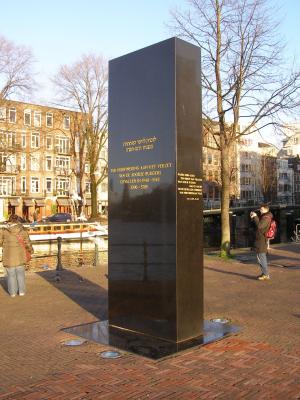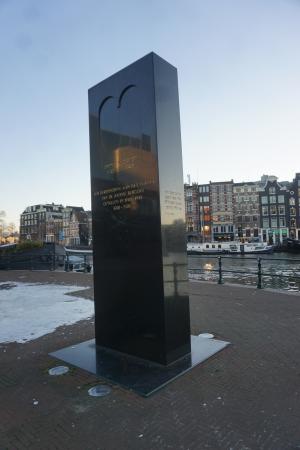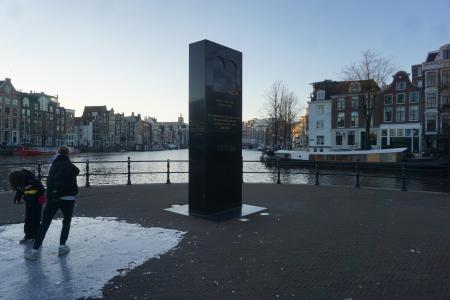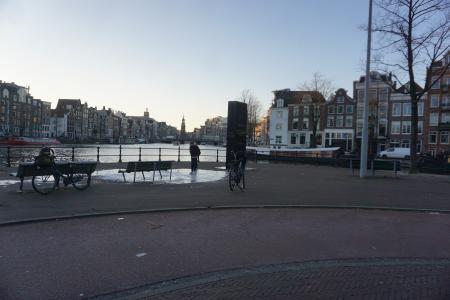Obj. ID: 53325
Modern Jewish Art Monument of Jewish Resistance in WWII in Amsterdam, The Netherlands, 1988

Name of Monument
Joods Verzetmonument
Translation: Jewish Resistance Monument
Who/What is Commemorated?
Members of the Jewish Resistance
Description
The monument is situated in front of the opera house, close to the water of the Amstel River. The shape of the Decalogue (Tablets of the Law) is cut into the side facing the opera house and beneath this is dedicatory inscription in Hebrew and Dutch. The same inscriptions without the Decalogue are on the side facing the water, A passage from Jeremiah is inscribed on the sides, on one side in Hebrew and in Dutch on the other.
Inscriptions
On the front and back sides, identical inscriptions in Hebrew and Dutch.
In Hebrew:
לזכרון לוחמי המחתרת
בשנות ת”ש - תש”ה
Translation: In memory of underground fighters / in years 5700 – 5705 [=1940-1945]
TER HERINNERING AAN HET VERZET
VAN DE JOODSE BURGERS
GEVALLEN IN 1940-1945
5700 – 5705
Translation: In memory of the resistance by Jewish citizens, killed in 1940-1945 / 5700 – 5705
On the sides of the monument, a passage from Jeremiah in Hebrew and Dutch:
מי יתן ראשי מים
ועיני מקור דמעה
ואבכה יומם ולילה
את חללי בת עמי
(ח כג) ירמיה
WAREN MIJN OGEN
EEN BRON VAN TRANEN
DAN ZOU IK WENEN,
DAG EN NACHT
OM DE GEVALLEN STRIJDERS
VAN MIJN DIERBAAR VOLK
(NAAR JER. 8,23)
Translation: Were my eyes a fountain of tears I would weep day and night for the fallen defenders of my beloved people (Jeremiah 8:23)
Commissioned by
Committee for the Jewish Resistance 1940-1945
sub-set tree:
The monument was an initiative of a Jewish former resistance fighter, Bennie Bluhm (1917-1986). During the occupation he formed vigilante groups to protect the neighborhood against the Weather Department (WA), the militia of the NSB.
The foundation, Committee Joods Verzet 1940-1945, established this monument on the day of Bluhm’s funeral.
According to Stoutenbeek and Vigeveno:
Above all, the monument is intended to make the statement that the Jewish people didn't simply let themselves be herded off to the death camps without raising a whisper of protest. Dutch Jews, among them Walter Siiskind, Gerhard Badrian and Eduard Veterman were active in resisting the Nazis. There is of course a fine line when it comes to distinguishing between active and passive resistance, the figures would seem to suggest that there was a relatively larger proportion of Jewish resistance fighters than there was among non-Jews. There was a federation of Resistance groups, named the Vrije Groepen Amsterdam, of whom one fifth of the members were Jewish, although the Jews formed one tenth of the population of Amsterdam. In the group 'Porgel and Porulan', formed by Bob van Amerongen and Jan van Hemelrijk, both half-Jewish, the majority were in fact Jewish. By organizing hiding places, this group managed to save about 50 people. At the very least we may conclude that the Dutch Jews were no more passive than their all-Dutch counterparts. (Jewish Amsterdam, p. 91)
The Night of Broken Glass, 8 to 9 November 1938 (Kristallnacht) is commemorated at the monument every year.
"Joods Verzetmonument / Jewish Resistance Memorial,"
The Historical Marker Database, https://www.hmdb.org/m.asp?m=100519., https://www.hmdb.org/ (accessed March 5, 2024)
Stoutenbeek, Jan and Paul Vigeveno. Jewish Amsterdam, trans. By Wendie Shaffer. (Amsterdam-Ghent: Ludion, 2003), pp. 90-91.





















